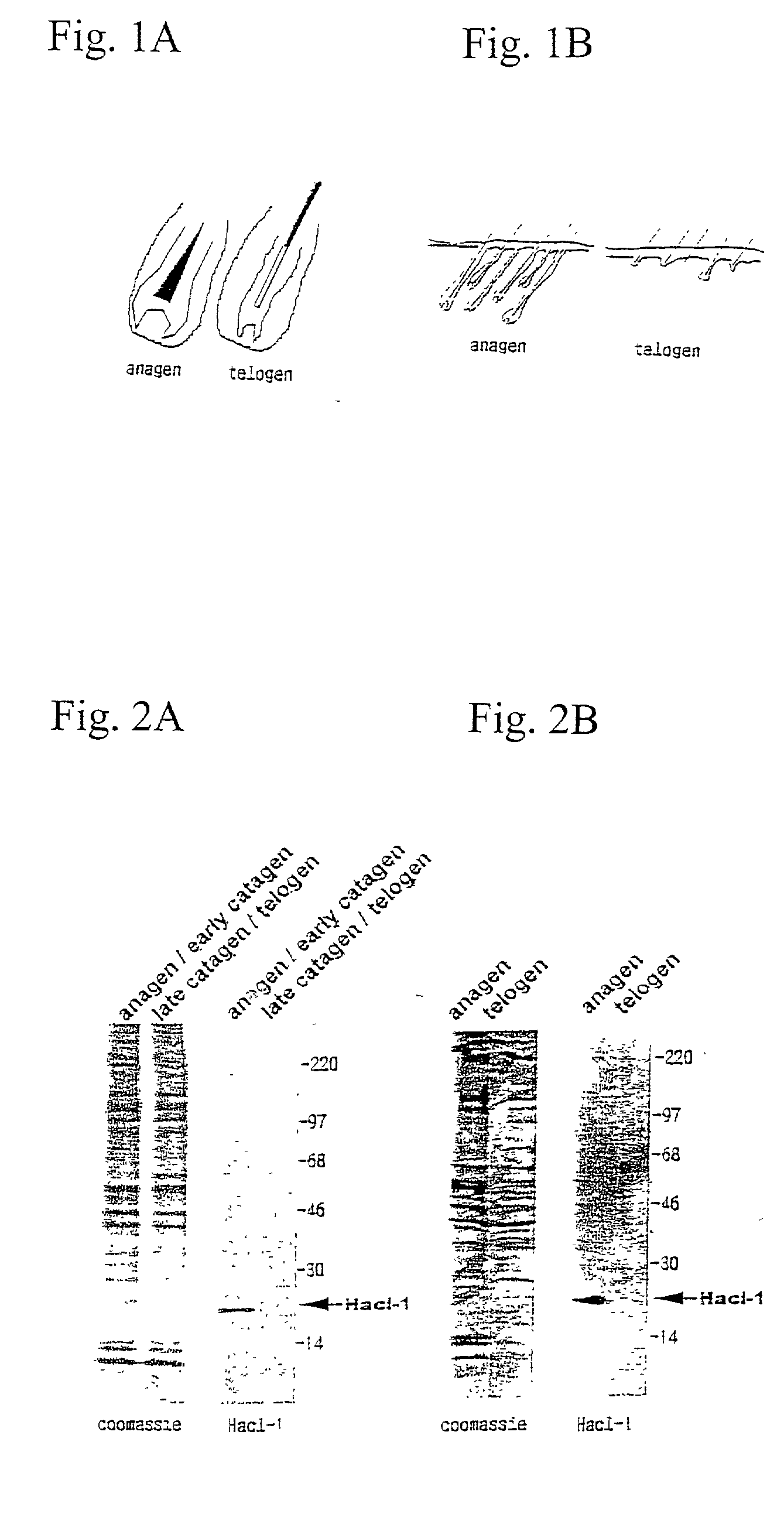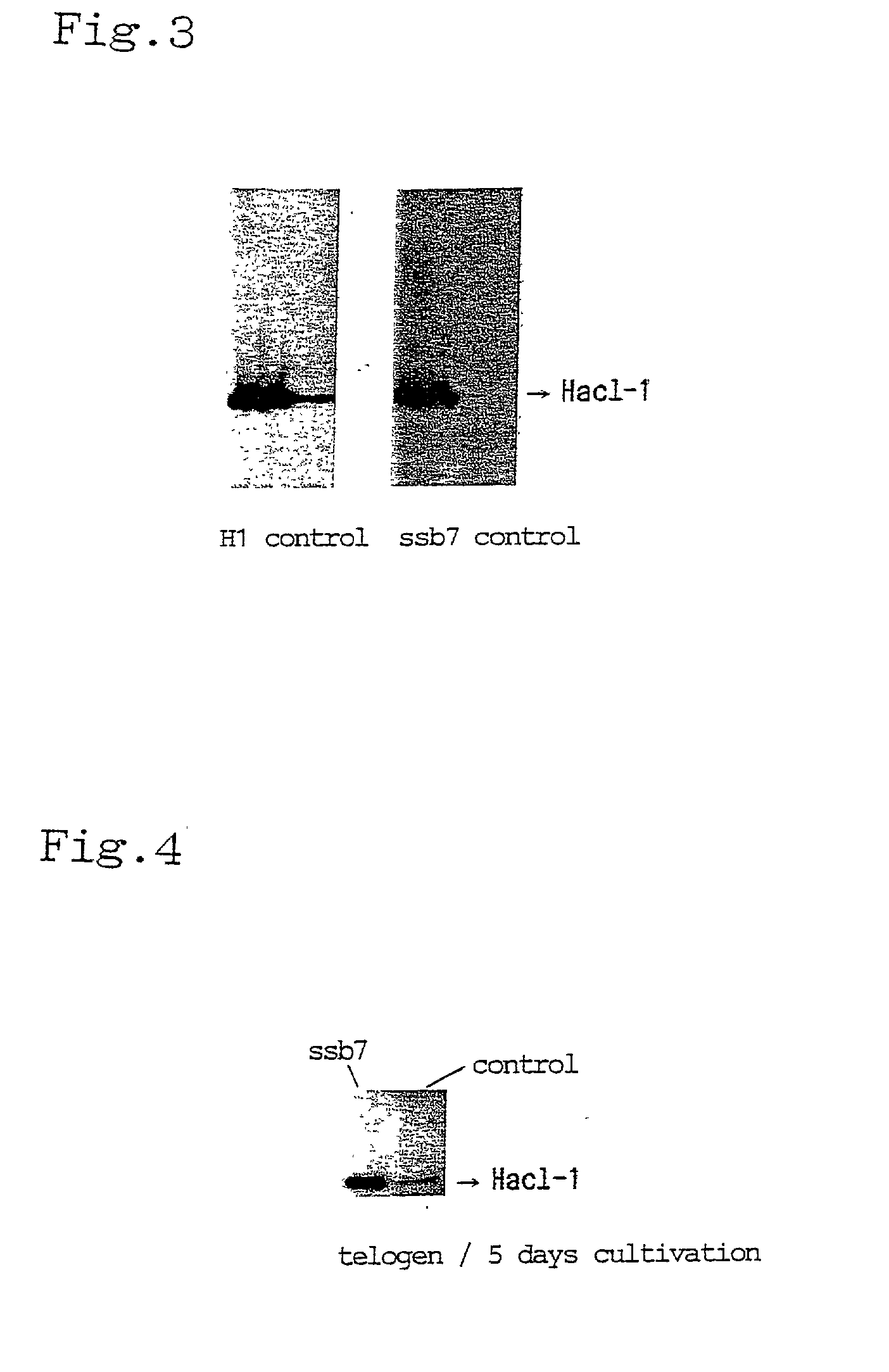Method for screening a substance having promoting activity on hair growth
- Summary
- Abstract
- Description
- Claims
- Application Information
AI Technical Summary
Problems solved by technology
Method used
Image
Examples
example 1
[0020] A DNA containing a gene encoding Hacl-1 (Huh, N. et al., The Journal of Investigative Dermatology, 102(5), pp. 716-720, 1994) was amplified by the PCR method, and by using the amplified product, Hacl-1 was expressed as a recombinant protein in Escherichia coli in a conventional manner. A rat was immunized with the recombinant Hacl-1 in a conventional manner to prepare an antiserum against Hacl-1.
[0021] Preparation of a antiserum was carried out as follows. The PCR method was carried out by using the cDNA library prepared from the beard tissue of a C3H mouse as the template to isolate a cDNA containing the entire reading frame of Hacl-1 (Huh, N. et al., J. Invest. Dermatol., 102, pp. 716-720, 1994). By using the isolated Hacl-1 gene as a template, a Hacl-1 gene added with 6 histidines at the N-terminal was isolated. The Hacl-1 gene added with 6 histidines at the N-terminal was integrated into an Escherichia coli expression vector, Pet3c (Novogen), and the vector was introduced...
example 2
[0025] Polypeptide H1 having morphogenesis promoting activity on epithelial cells, which is described in International Publication WO 98 / 22505 (a polypeptide consisting of 104 amino acids represented by amino acid sequence (II) disclosed in the aforementioned international publication) was expressed in Escherichia coli according to the method described in International Publication WO 98 / 22505. As a control, a supernatant obtained by lysis of the Escherichia coli was used which was not transformed with the recombinant vector encoding the aforementioned polypeptide.
[0026] Separately, oligopeptides having the amino acid sequence (I): Ser-Ile-Glu-Gln-Ser-Cys-Asp-Gln-Asp-Glu were synthesized by the solid phase method using Fmoc (referred to as "pep7" in the examples). Each oligopeptide synthesized was purified by high-performance liquid chromatography (HPLC), and their purities were found to be 90% or higher by HPLC and Mass. The conditions and retention time of HPLC were as follows:
[002...
example 3
[0036] The beard on the both sides of the mice used in Example 2 was collected and cultured by the method described in Development, 105, pp. 271-277, 1989. The beard from one side was used as a control, and that from the other side was treated with the aforementioned oligopeptide ssb7 (50 .mu.g / ml). After cultivation for 5 days, Hacl-1 in the cultures was determined according to the method of Example 1. As a result, expression of Hacl-1 was observed in the beard treated with the oligopeptide ssb7, but only slight expression of Hacl-1 was observed in the control. The results are shown in FIG. 4.
PUM
 Login to View More
Login to View More Abstract
Description
Claims
Application Information
 Login to View More
Login to View More - R&D
- Intellectual Property
- Life Sciences
- Materials
- Tech Scout
- Unparalleled Data Quality
- Higher Quality Content
- 60% Fewer Hallucinations
Browse by: Latest US Patents, China's latest patents, Technical Efficacy Thesaurus, Application Domain, Technology Topic, Popular Technical Reports.
© 2025 PatSnap. All rights reserved.Legal|Privacy policy|Modern Slavery Act Transparency Statement|Sitemap|About US| Contact US: help@patsnap.com


